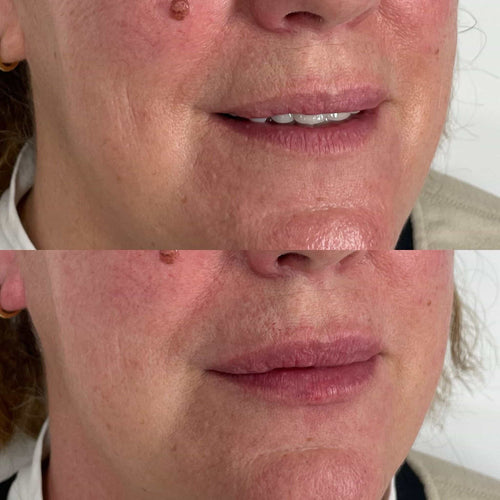Arrange a Dermal Filler Session with Dr. Laura Geige Now
Individual Factors

Age
Age is a significant individual factor influencing tear trough filler needs and longevity. As we age, natural changes occur in our facial structure that contribute to under-eye hollowness.
Here’s a breakdown of how age impacts tear trough concerns and filler treatments:
Schedule a Dermal Filler Consultation with Dr. Laura Geige Now

-
Loss of Fat and Collagen: With time, the fat pads supporting the under-eye area naturally decrease in volume. Simultaneously, collagen production, which provides skin firmness and elasticity, diminishes. This combination leads to a hollowing effect beneath the eyes.
-
Skin Thinning: As we age, the skin around the eyes thins, making underlying blood vessels more visible. This can contribute to a dark under-eye appearance, further accentuating the hollowness.
-
Changes in Facial Structure:** Gravity and fat redistribution throughout the face also play a role. Fat pads may migrate downwards, leading to more pronounced under-eye hollowing.
Because these age-related changes are gradual, individuals might not notice significant tear trough concerns until their mid-30s or later. However, the rate of these changes varies significantly from person to person.
It’s important to note that individual factors beyond age also influence tear trough filler needs:
*
Genetics:** Some individuals are genetically predisposed to thinner skin and less prominent fat pads, making them more susceptible to under-eye hollowness at an earlier age.
*
Sun Exposure:** Excessive sun exposure damages collagen and elastin fibers, accelerating skin aging and increasing tear trough prominence.
*
Lifestyle Factors: Smoking, poor nutrition, dehydration, and lack of sleep can all contribute to premature aging and worsen the appearance of under-eye hollows.
Consult with a board-certified dermatologist or plastic surgeon to determine the most appropriate treatment plan based on your individual needs and concerns.
Skin Condition
Individual factors play a significant role in determining how often someone may need tear trough filler injections. These factors can influence both the longevity of the results and the individual’s unique aesthetic goals.
Skin type is a crucial consideration. Oily skin tends to metabolize fillers more quickly, requiring more frequent touch-ups compared to individuals with dry or normal skin. Thicker skin may also allow for longer-lasting results as the filler is less likely to be readily absorbed by the body.
Facial structure and volume loss patterns contribute significantly. Individuals with pronounced tear troughs or significant volume depletion in the under-eye area may require more frequent treatments to maintain desired fullness and minimize shadows.
Lifestyle choices can also impact filler longevity. Smoking, excessive sun exposure, and poor nutrition can accelerate skin aging and breakdown of fillers, leading to shorter-lasting results.
Health conditions, such as certain autoimmune disorders, may affect the body’s response to fillers, potentially requiring more frequent touch-ups or even making filler injections less suitable.
Secure Your Dermal Filler Appointment with Dr. Laura Geige
Finally, individual aesthetic preferences influence treatment frequency. Some individuals may opt for a subtle, natural look and be content with longer intervals between treatments, while others may prefer a more dramatic enhancement requiring more frequent touch-ups to maintain their desired appearance.
Lifestyle
Individual factors play a significant role in determining how often tear trough filler injections are needed for optimal results. Skin elasticity and thickness, collagen production, facial structure, and natural fat loss patterns all contribute to the longevity of filler effects.
Individuals with thinner skin and less collagen tend to experience quicker breakdown of filler, requiring more frequent touch-up appointments. Conversely, those with thicker skin and robust collagen production may enjoy longer-lasting results.
Lifestyle factors can also influence tear trough filler longevity. Sun exposure accelerates collagen breakdown and skin aging, potentially diminishing the effects of filler sooner. Similarly, smoking and excessive alcohol consumption can impair collagen synthesis and wound healing, leading to faster filler degradation.
Facial expressions, particularly frowning and squinting, can also contribute to premature filler loss in the tear trough area. Frequent muscle contractions can create wrinkles and disrupt the smooth appearance achieved with fillers.
Genetics plays a role in determining individual skin characteristics and aging patterns, impacting how quickly tear trough filler may be absorbed.
Maintaining a healthy lifestyle with sun protection, adequate hydration, and a balanced diet rich in antioxidants can help support collagen production and potentially extend the duration of tear trough filler results.
It’s essential to consult with a qualified and experienced injector who can assess your individual anatomy, skin type, and lifestyle factors to determine the most appropriate frequency for tear trough filler touch-ups.
Treatment Frequency Guidelines
Initial Treatment Schedule
Treatment frequency guidelines for tear trough filler are not standardized and can vary depending on individual factors such as the patient’s age, skin type, desired outcome, and the specific filler used.
A general guideline suggests that touch-up appointments may be needed every 6 to 18 months.
Initial treatment schedules typically involve a single injection session followed by follow-up appointments as needed.
The initial amount of filler injected will depend on the severity of the tear troughs and the patient’s desired outcome.
During the initial consultation, a qualified practitioner will assess your individual needs and recommend an appropriate treatment plan.
Some patients may experience longer-lasting results with certain fillers or techniques.
It’s important to have realistic expectations and understand that touch-up appointments are often required to maintain the desired aesthetic result.
Maintenance Fillers
Tear trough filler treatment frequency depends on several factors, including the individual’s anatomy, skin type, lifestyle, and product used. Generally, initial results from tear trough fillers can last anywhere from 6 to 18 months.
Maintenance treatments are typically recommended every 6 to 12 months to maintain the desired results and prevent volume loss. The specific frequency of touch-up appointments will be determined during a consultation with a qualified injector, who will assess your individual needs and goals.
Several factors influence how long tear trough filler lasts:
- Product Type: Different fillers have varying compositions and lifespans. Some hyaluronic acid-based fillers are designed for longer-lasting results than others.
- Individual Metabolism: People metabolize substances at different rates, which can affect how quickly a filler is broken down by the body.
- Sun Exposure: Excessive sun exposure can degrade collagen and elastin, accelerating the breakdown of filler.
- Smoking:**
- Facial Expressions:**
Smoking also damages collagen and elastin, reducing the longevity of filler results.
Frequent facial expressions can contribute to filler migration and a quicker need for touch-ups.
During your initial consultation, discuss your desired outcome, lifestyle, and budget with your injector. This will help them determine the best course of treatment and maintenance schedule for you.
Long-Term Considerations
Treatment frequency for tear trough filler depends on several factors, including individual skin characteristics, product used, and desired results.
Generally, initial results can last anywhere from 6 to 18 months. However, the longevity of tear trough fillers can vary considerably.
Some individuals may require touch-up appointments every 6 months, while others might only need them annually or even less frequently.
Long-term considerations for tear trough filler include potential complications like swelling, bruising, and infection, although these are relatively rare when performed by a qualified practitioner.
Additionally, repeated injections can lead to collagen loss over time, making future treatments less effective.
Therefore, it’s crucial to have realistic expectations and discuss long-term maintenance with your injector.
They can tailor the treatment plan to your specific needs and goals while minimizing potential risks.
Signs You May Need a Touch-Up
Fading or Loss of Volume
Several signs may indicate it’s time for a touch-up of tear trough filler, as volume naturally diminishes over time.
Here are some telltale signs:
- Deepening Under Eye Hollows: The hollows beneath your eyes become more pronounced, leading to an accentuated shadow or a tired appearance.
- Loss of Smoothness: The tear trough area may feel less smooth and plump, with noticeable lines or creases becoming more apparent.
- Dark Circles Become More Prominent: Filler helps camouflage dark circles by adding volume. If they appear darker or more defined, it might be time for a refresh.
- Unevenness or Migration of Filler: The filler may have shifted slightly over time, causing asymmetry or unevenness in the tear trough area.
Remember that individual results vary, and the frequency of touch-ups depends on factors like product used, metabolism, lifestyle, and sun exposure. Consulting with a qualified aesthetic practitioner is essential for personalized advice and treatment plans.
Unevenness or Asymmetry
Unevenness or asymmetry can occur when filler is injected unevenly, leading to one side looking fuller than the other. This can be a noticeable imperfection that affects the overall aesthetic.
Other signs you might need a touch-up include: subtle hollowing under the eyes, even if it’s not dramatic, as your natural volume gradually depletes over time.
The appearance of “shadows” or deepening of tear troughs can also indicate that the filler has been reabsorbed and needs replenishment.
If you find yourself constantly trying to mask imperfections with makeup, it’s a good sign that your filler is losing its effectiveness and a touch-up is in order.
Lastly, if you are unhappy with the overall appearance of your tear troughs or notice any changes that concern you, don’t hesitate to consult with your injector. They can assess the situation and determine if a touch-up or further adjustments are necessary.
Development of New Wrinkles
One of the most obvious signs you may need a tear trough filler touch-up is a loss of volume or plumpness under your eyes. As the hyaluronic acid filler gradually breaks down over time, this area can begin to appear hollowed out again.
You might notice fine lines and wrinkles becoming more prominent in the tear trough area. This could indicate that the filler has lost its ability to smooth out the skin and fill in these imperfections.
If you find yourself looking tired or exhausted, even after a good night’s sleep, your tear troughs may be showing signs of depletion. The lack of volume can cast shadows under your eyes, making you appear more fatigued.
Another potential indicator is a deepening of the under-eye hollows. As the filler breaks down, the natural contours of your face can become more pronounced, leading to a more noticeable indentation beneath your eyes.
If you notice that your makeup doesn’t blend as seamlessly as it used to under your eyes, this could be a sign that the filler needs a refresh. The loss of volume can cause makeup to settle into fine lines and wrinkles, making it appear less even.
It’s important to remember that individual results vary, and touch-up schedules will depend on factors like skin type, metabolism, lifestyle, and the specific product used.
Ultimately, if you are concerned about the appearance of your tear troughs or feel they are no longer providing the desired effect, consult with a qualified medical professional for advice and personalized recommendations.
Andrea McGinty Art Cafe Sant Jaume Valencia Pinnacle Wellbeing Media K’s P Rules Cakes
- Skin Pen Microneedling Near Stoke D’Abernon, Surrey - November 17, 2025
- Skin Pen Microneedling Near Elstead, Surrey - November 16, 2025
- Skin Injectables Near Selhurst, Surrey - November 13, 2025

